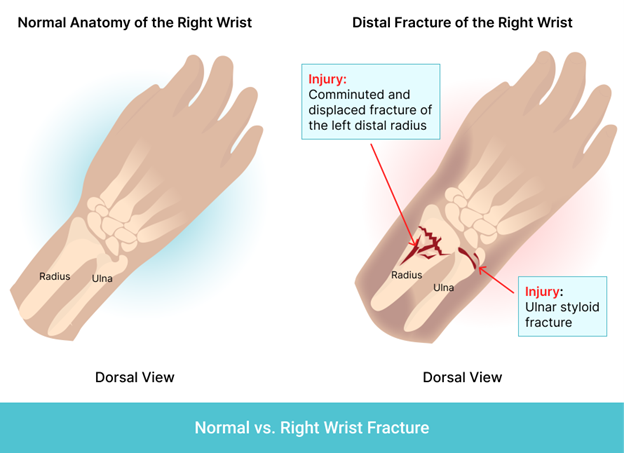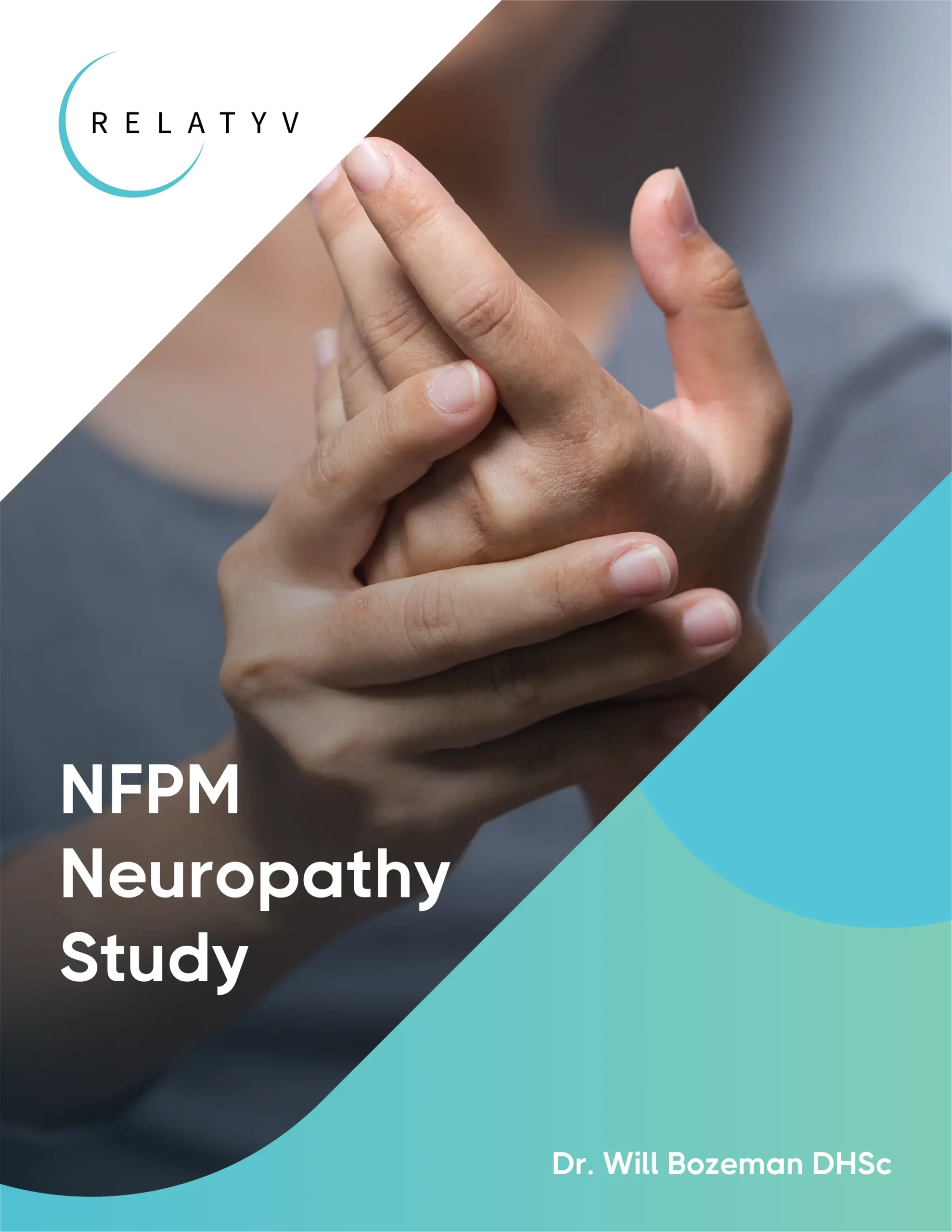A broken wrist is a relatively common injury that can happen to anyone. This type of fracture typically occurs from direct impact to the wrist, such as a sports injury or a fall onto an outstretched hand. A broken wrist can significantly impact your daily activities and hinder your ability to use your hand correctly. Even after the initial treatment and healing process, proper care and rehabilitation are crucial for maintaining long-term wrist health. Fortunately, we offer a whole-person approach to help manage chronic pain caused by broken wrists.
What Is A Distal Radius Fracture?
A distal radius fracture is a wrist injury that specifically affects the radius bone, which is one of two long bones in the forearm that run from the elbow to the wrist. The distal end of the radius is located at the wrist joint. It is responsible for connecting the hand to the forearm. There are eight small bones in the wrist joint, which allow the hand and arm to have a wide range of motion. A distal radius fracture can vary in severity, from a mild crack to a complete break through the bone.
A Comparison Between A Normal And Fractured Wrist
In a normal wrist, the radius and ulna bones work together to support the hand and allow for movement. The joint between these two bones is covered in cartilage, which helps reduce friction and allows for smooth movement. Ligaments, tendons, and muscles also play a crucial role in supporting the wrist joint.
In a fractured wrist, one or both of these bones may be broken, disrupting the proper alignment and stability of the joint. Such a fracture can lead to pain, swelling, and difficulty moving the hand and wrist.

Types Of Wrist Bone Fractures
Because the wrist consists of several small bones, there are different types of fractures that can occur. These include:
- Scaphoid fracture: This is a fracture of the scaphoid bone, which is located on the side of the wrist leading up to the thumb. This type of fracture can affect the stability and function of the wrist joint due to its location and role in supporting the thumb.
- Distal radius fracture: As noted above, this kind of fracture happens at the end of the radius bone near the wrist joint. It is one of the most common types of wrist fractures.
- Chauffer’s (radial styloid) fracture: This fracture affects the radial styloid, which is a small bony bump on the thumb side of the wrist.
- Barton’s fracture: This type of fracture occurs when the wrist joint is dislocated, causing the bones to break. It can have serious implications and may require surgery for proper treatment due to the complexity of the injury.
- Ulnar styloid fracture: This fracture affects the ulnar styloid, which is a small bony bump on the pinky side of the wrist.
Pain And Other Symptoms Linked To Wrist Fractures
Wrist fractures often cause intense pain and discomfort, especially with movement. In addition to pain, other common symptoms of a broken wrist include:
- Bruising: A bruise is a discoloration of the skin caused by damaged blood vessels leaking blood into the surrounding tissues. Bruising is a common symptom of a wrist fracture due to the impact or trauma that caused the injury.
- Bone swelling: Bone swelling, also known as periosteal edema, is a buildup of fluid in the tissues surrounding the fracture site. This can cause visible swelling or a bump near the broken bone and may feel firm to the touch. Bone swelling is caused by inflammation in response to the fracture.
- Inability to move the wrist: When the wrist is fractured, it may be difficult or impossible to move the hand and fingers normally. This is due to the pain, swelling, and instability caused by the fracture. In more severe cases, the wrist may become completely immobilized.
Sensation Of Numbness
Feeling a numbness in your body can be a scary and uncomfortable experience. This numbness, also known as paresthesia, is a tingling or prickling sensation that can occur anywhere in the body. It is often described as feeling like pins and needles or a loss...
Hand Weakness
Experiencing persistent weakness in your hands can significantly impact your quality of life. If you have weakness in your hands, it can be difficult to perform everyday tasks. It can be especially problematic if you use your hands to perform your job. If you...
Tenderness And Pain When Touched
The signs and symptoms of tenderness and pain vary depending on the underlying cause. Generally, people who suffer from this type of sensation will feel an overwhelming discomfort when their skin is touched or pressed against something. This pain may be...
Why Do Wrist Fractures Occur?
Understanding the causes and risk factors of wrist fractures can help prevent future injuries. The most common causes of a wrist fracture include:
Age
As we age, our bones become more brittle and prone to fractures. This is because as we get older, our bodies produce less bone tissue, and the calcium levels in our bones decrease. This makes them weaker and more susceptible to breaks. As older individuals tend to be at a higher risk of falling, this further increases the risk of wrist fractures.
Gender
Women are more likely to experience wrist fractures, especially after menopause. This is the result of hormonal changes that can weaken bones by reducing bone density. Hormonal changes can also cause a lack of coordination and balance, putting women at a higher risk of falling.
Falls And Accidents
Falls, particularly onto an outstretched hand, are the leading cause of wrist fractures. Car accidents and other high-impact accidents can also result in wrist fractures.
Injuries
Injuries such as sports-related impacts or direct trauma to the wrist can cause fractures. For instance, a direct blow to the wrist while playing softball or football can result in a fracture.
In some cases, repetitive stress injuries may also contribute to a broken wrist. For example, a gymnast may experience fractures from repeatedly landing on their hands.
Medical Conditions
Certain medical conditions can weaken bones and increase the risk of fractures. It is essential to manage these conditions to prevent future injuries. The following medical conditions are linked to an increased risk of wrist fractures:
Osteoporosis
Osteoporosis is characterized by brittle and weak bones, making them more prone to fractures. It often affects older individuals, postmenopausal women, and those with a family history of the disease.
Osteogenesis Imperfecta
Osteogenesis imperfecta is also referred to as brittle bone disease. It’s a genetic disorder that causes bones to be more fragile and prone to fractures.
Cancer
Cancer can weaken bones and make them more susceptible to fractures. Certain cancer treatments, such as chemotherapy, may also increase the risk of bone fractures due to their impact on bone density.
Potential Risks Associated With An Untreated Broken Wrist
It is important to seek medical treatment for a broken wrist as soon as possible. Leaving a fractured wrist untreated can lead to potential risks and complications, including:
- Malunion: When a bone heals in an incorrect position, it is called malunion. This can result in permanent deformity and reduced hand and wrist function.
- Nonunion: Nonunion occurs when a bone fails to heal after an extended period of time. Nonunion can lead to chronic pain and decreased mobility.
- Nerve damage: A broken wrist can lead to nerve damage, thereby resulting in symptoms such as tingling, numbness, and weakness in the hand and fingers.
- Arthritis: If a fracture damages the cartilage or joint surfaces of the wrist, it can lead to arthritis. This can cause persistent pain and stiffness in the joint.
- Compartment syndrome: In rare cases, a broken wrist can result in compartment syndrome, which is a serious condition caused by increased pressure within a muscle compartment. This can cut off blood flow and damage nerves and muscles. If left untreated, compartment syndrome can be life-threatening.
How Is Wrist Fracture Diagnosed?
If you’re experiencing any of the symptoms listed earlier, it is vital to seek medical attention immediately. A doctor will conduct a routine physical exam and may also order diagnostic tests to confirm a wrist fracture. These tests may include:
- X-ray: This is the most common diagnostic test for bone fractures. X-rays create images of bones using low levels of radiation.
- CT scan: A CT scan provides more detailed images than a regular X-ray. It can help doctors identify more complex fractures and determine their severity.
- MRI: An MRI produces detailed images of bones and soft tissues by using powerful magnets and radio waves. This test is often used to examine complex fractures or to detect any nerve or ligament damage.
- Bone scan: A bone scan involves injecting a tiny (and safe) amount of radioactive substance into the bloodstream. This allows doctors to detect any areas of increased bone activity, which can indicate a fracture.
- Dual-energy X-ray absorptiometry (DXA): This test measures bone density and can help diagnose osteoporosis.
Common Treatment Options
Most traditional doctors will recommend more conventional methods for treating wrist fractures. Some of the more common treatment options for a fractured wrist include the following:
Medications
If you’re experiencing pain or swelling, over-the-counter (OTC) pain relievers like acetaminophen or ibuprofen can provide relief. In more severe cases, your doctor may prescribe a stronger pain medication. However, pain medications (especially prescription ones) can have side effects and may be habit-forming. I addition, they don’t help heal the fracture and only address the symptoms.
Immobilization
Immobilizing the wrist can help alleviate pain and prevent further injury. This is achieved through splinting or casting, which keeps the bones in proper alignment while they heal.
Physical Therapy
Physical therapy can help regain mobility, flexibility, and strength in the wrist after a fracture has healed. A physical therapist may also recommend exercises to improve grip strength and prevent future injuries.
Surgery
Surgery is typically reserved for more severe fractures or cases where the bones are not aligned properly. Surgery is incredibly invasive and can be risky as well since it involves cutting the skin and using screws, pins, or plates to hold the bones in place. It could potentially lead to complications or infection.
That said, the following are the two types of surgery used to treat wrist fractures:
- Closed reduction: This involves manipulating the bones back into place without making any incisions. It’s typically performed under local or general anesthesia and can be done in an outpatient setting. Although not as invasive, there’s still a risk of nerve damage or further bone damage if the bones are not aligned properly.
- Open reduction: This type of surgery involves making an incision to realign the bones and then using plates, screws, or pins to hold them in place. It’s a more invasive approach that may require a hospital stay and carries a higher risk of infection or nerve damage. Additionally, recovery time for this surgery is longer compared to closed reduction.
Can Broken Bones Heal Faster With Conventional Treatment?
While conventional treatments for wrist fractures can be effective in most cases, the bones can take a considerable amount of time to fully heal. This is due to the natural healing process of bones, which can take anywhere from six to eight weeks or longer, depending on the severity of the fracture.
However, conventional treatment can not only result in longer recovery times, but it can also be invasive and carry risks of complications.
We offer an alternative treatment plan that is non-invasive, non-surgical, and drug-free. Our treatment protocol can help expedite the healing process and provide relief from pain and discomfort.
If you’ve already undergone surgery to repair a wrist fracture, our Neuragenex Neurofunctional Pain Management Protocol can still be beneficial by reducing inflammation and chronic pain that may have developed after the surgery, or that may have continued to linger post-surgery.
Our Approach For Pain Relief And Accelerated Healing In A Broken Wrist
We use a Neurofunctional Pain Management approach to help patients with wrist fractures. Essentially, we use several treatment modalities (all of which are drug-free and non-invasive) to target the neurological causes of pain and promote accelerated healing. The following are some of the methods we use as part of our whole-person approach to pain management:
Electroanalgesia
Electroanalgesia is a pain management technique that uses high-pulse electrical current to ease pain, boost blood circulation, improve mobility, and induce...
IV Therapy
IV nutritional therapy, or intravenous therapy, involves administering vital nutrients directly to the bloodstream through an IV. This type of treatment bypasses the digestive system, allowing for maximum absorption and utilization of nutrients by the...
Lifestyle Counseling
Lifestyle counseling is an approach to managing chronic pain that involves identifying, assessing, and modifying lifestyle factors contributing to an individual's pain. For example, lifestyle factors such as nutrition, physical activity, stress, sleep quality...
Rediscover The Joy Of Living
With Neuragenex NFPM, our goal is to help patients rediscover the joy of living by providing a comprehensive and personalized treatment plan for pain relief. By targeting the underlying neurological causes of your wrist pain, we offer a safe and efficient alternative to traditional treatments.
With our experienced team, we strive to provide the best care for our patients. Contact us today to learn more about Neuragenex NFPM protocol and how we can help you on your journey to recovery from a wrist fracture.
Take proactive steps to alleviate the pain associated with wrist bone fractures.



